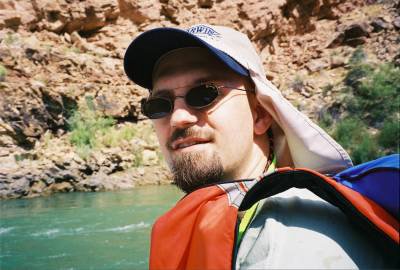R.A.T.E. and Fission Tracks
One might be tempted to say that of all the RATE team’s projects, the one dealing with radiohalos was the weakest. But the one dealing with fission tracks is equally poor, if not outright worse. Andrew Snelling again takes point on this project, and an objective reading will safely conclude that his work is again profoundly rickety, at best. A thorough recount will therefore neither be needed nor given here. Only a brief overview is needed.
Now, to clarify some things, it would help to give a crash-course in fission-track dating. The idea is that after a crystal forms, radio-decay will emit particles out of and through the solid crystal. This has the effect of "scoring" or "scratching" the crystalline structure at the atomic level, because the mass of the emitted particle slices through the surrounding atoms. This leaves a track, much the same way that a bicycle tire leaves a track through gravel. If acid is added to the crystal surface, the tiny atomic tracks can be widened, because with each successive layer of atoms removed by the acid, the "groove" becomes deeper. Eventually, one can see these tracks with a high enough resolution microscope, and then be able to count them. From this, one can make an estimate as to the age of the crystal, dating from the time it initially hardened.
To conduct his study, Snelling selected samples from a few locations, including the Cambrian Muav and Tapeats tuffs from the western Grand Canyon (which he ascribes to being “early Flood”), Jurassic Morrison Formation tuff beds in southeastern Utah (“middle Flood”), and the Miocene Peach Springs Tuff, southeastern California (“post Flood”). The fission track ages of the zircon grains in these samples was determined by Action Laboratories in Ontario using the external detector method and a zeta calibration factor. The fission track dating estimates were the same as the ages determined using U-Pb isotope measurements, and a thermal resetting event in the Grand Canyon samples corresponded precisely with the onset of the Laramide uplift of the Colorado Plateau. These results clearly indicated that more than 500 million years worth of radioisotope decay has taken place (“at today’s rates”), yet Snelling concludes that this is evidence for the same sort of accelerated nuclear decay that has been cited in the other RATE research papers.
There is nothing in Snelling’s evaluation of fission tracks that would, by itself, cause one to conclude that millions of years worth of radioactive decay had taken place. In other words, nothing indicates accelerated decay. To make that case, he calls upon independent verification of such a conclusion from other sources. And which sources does he cite? Why, you guessed it! The same work by Humphreys, Austin, and himself, as cited in earlier on this blog! (He also cites one other reference by Baumgardener, which will be dealt with shortly.) He simply researches the fission tracks, obtains dates reasonably consistent with old-earth geology, and then claims they support a young earth anyway. Not only does the Emperor have no clothes, but the clothes have no Emperor, either.
Even more fatal to his interpretation is the annealing of the fission tracks in the Grand Canyon samples, caused by the same geologic events responsible for the Kaibab upwarp. Snelling claims that it was accelerated decay which heated the zircons enough to erase the fission tracks and reset the radioisotope clock. But this same accelerated decay is also purportedly responsible for more than fifty million years of fission tracking since that point. So there is an inherent contradiction in his version of events. Either the accelerated decay would have heated the zircons enough to all but completely wipe out any fission tracks, or the accelerated decay did not take place within the past 50 million years – more than enough to disprove his 6,000-year creationist paradigm anyway. To reconcile this problem, Snelling again invokes the obligatory “rapid cooling” event, for which he has no evidence.


0 Comments:
Post a Comment
<< Home